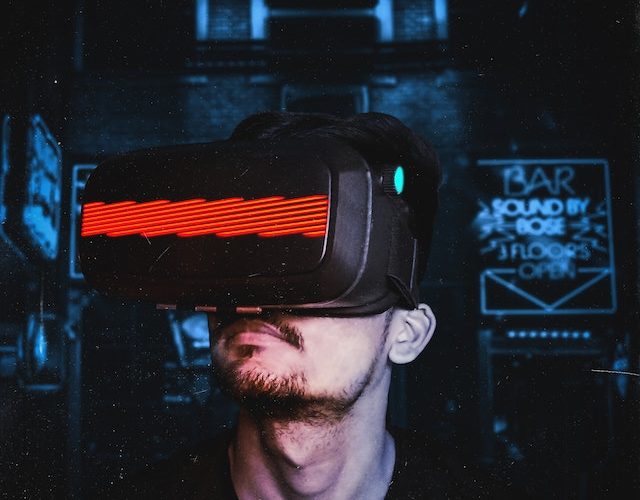VR Redefined: How Generative AI Enhances Immersive Experiences
Introduction
Hello, I am Fred, a VR expert and a generative AI enthusiast. I have been fascinated by the possibilities of combining these two technologies to create immersive and interactive experiences that go beyond the boundaries of reality. In this article, I will explore how generative artificial intelligence is shaping the future of VR by enhancing realism, personalization, and creativity.
VR, or virtual reality, is a technology that simulates a three-dimensional environment that can be experienced and manipulated by the user. VR can create a sense of presence, immersion, and agency, allowing the user to feel like they are in a different world. VR can be used for various purposes, such as entertainment, education, training, therapy, and social interaction.
Generative AI, or artificial intelligence that can generate new and original outputs, is a branch of AI that has been making remarkable progress in recent years. Generative artificial intelligence can create realistic and diverse content, such as images, text, music, and code, based on some input or data. Generative AI can also learn from the user’s feedback and preferences, and adapt its output accordingly. Generative AI can be used for various purposes, such as art, design, communication, and innovation.
VR and generative artificial intelligence are closely related, as they both aim to create engaging and meaningful experiences for the user. By combining VR and generative AI, we can achieve a new level of immersion, personalization, and creativity in VR environments, scenarios, and narratives. In this article, I will show you how generative AI can enhance realism, personalization, and creativity in VR, and what benefits it can bring for VR enthusiasts, AI engineers, and content creators.
How Generative AI Enhances Realism in VR Environments
One of the main challenges of VR is to create realistic and detailed environments that can fool the user’s senses and make them believe that they are in a different world. However, creating such environments can be time-consuming, costly, and limited by the available resources and tools. This is where generative AI can help, by creating realistic and diverse images, textures, and objects for VR environments, based on some input or data.
Generative AI is a term that encompasses various techniques and models that can generate new and original outputs, such as images, text, music, and code, based on some input or data. Some of the most popular and powerful generative artificial intelligence techniques are generative adversarial networks (GANs), variational autoencoders (VAEs), and transformers. These techniques can learn from large amounts of data, such as images, text, music, and code, and generate new and realistic outputs that resemble the data.
For example, ChatGPT is a generative artificial intelligence model that can generate realistic and coherent text conversations, based on some initial input or context. ChatGPT can be used to create interactive and engaging dialogues for VR characters, such as NPCs, avatars, or chatbots. ChatGPT can also adapt its responses to the user’s input and feedback, creating a personalized and dynamic conversation.
Another example is DALL.E, a generative artificial intelligence model that can generate realistic and diverse images, based on some text input or description. DALL.E can be used to create novel and varied images, textures, and objects for VR environments, such as landscapes, buildings, animals, or plants. DALL.E can also combine different concepts and styles, creating unique and creative outputs.
The benefits of generative AI for VR realism are manifold, such as:
- Improved visual quality: Generative AI can create realistic and detailed images, textures, and objects for VR environments, enhancing the visual quality and fidelity of the VR experience.
- Increased immersion: Generative AI can create diverse and dynamic content for VR environments, increasing the immersion and presence of the user in the VR world.
- Reduced development costs: Generative AI can reduce the development costs and time of creating VR environments, by automating and simplifying the content creation process.

How Generative AI Improves Personalization in VR Experiences
Another main challenge of VR is to create personalized and adaptive experiences that can cater to the user’s preferences, needs, and feedback. However, creating such experiences can be difficult, as they require a deep understanding of the user’s profile, behavior, and goals. This is where generative AI can help, by customizing VR content according to the user’s preferences, needs, and feedback, based on some input or data.
Generative AI can not only generate new and original outputs, but also learn from the user’s input and feedback, and adapt its output accordingly. Generative AI can use various techniques and models to learn from the user’s profile, behavior, and goals, such as reinforcement learning, inverse reinforcement learning, and active learning. These techniques can enable generative artificial intelligence to optimize its output for the user’s satisfaction, engagement, and learning outcomes.
For example, Ada is a generative artificial intelligence model that can customize VR content according to the user’s preferences, needs, and feedback, based on some input or data. Ada can be used to create personalized and adaptive VR experiences, such as games, stories, or simulations. Ada can also adjust the difficulty, pace, and style of the VR experience, based on the user’s performance, progress, and feedback.
Another example is SkinVision, a generative artificial intelligence model that can customize VR content according to the user’s skin type, condition, and goal, based on some input or data. SkinVision can be used to create personalized and adaptive VR experiences, such as beauty, wellness, or health. SkinVision can also provide the user with tailored advice, recommendations, and solutions, based on the user’s skin analysis, diagnosis, and feedback.
The benefits of generative AI for VR personalization are manifold, such as:
- Enhanced engagement: Generative AI can create personalized and adaptive VR content that matches the user’s preferences, needs, and feedback, enhancing the engagement and enjoyment of the user in the VR experience.
- Increased retention: Generative AI can create personalized and adaptive VR content that adapts to the user’s performance, progress, and feedback, increasing the retention and loyalty of the user in the VR experience.
- Improved learning outcomes: Generative AI can create personalized and adaptive VR content that optimizes the user’s satisfaction, engagement, and learning outcomes, improving the user’s skills, knowledge, and behavior in the VR experience.
How Generative AI Boosts Creativity in VR Content Creation
Another main challenge of VR is to create creative and innovative content that can inspire and delight the user. However, creating such content can be challenging, as it requires a high level of imagination, originality, and diversity. This is where generative artificial intelligence can help, by assisting VR content creators in generating new and unique outputs, such as images, text, music, and code, based on some input or data.
Generative AI can not only generate realistic and diverse outputs, but also generate novel and unique outputs, that can surprise and impress the user. Generative AI can use various techniques and models to generate new and original outputs, such as images, text, music, and code, based on some input or data, such as text, image, sound, or code. These techniques can enable generative artificial intelligence to assist VR content creators in generating new and unique outputs, such as images, text, music, and code, for VR content creation, such as art, design, communication, and innovation.
For example, DALL.E is a generative AI model that can generate novel and unique images, based on some text input or description. DALL.E can be used to assist VR content creators in generating new and unique images, textures, and objects for VR content creation, such as art, design, communication, and innovation. DALL.E can also combine different concepts and styles, creating unique and creative outputs.
Another example is Jukebox, a generative AI model that can generate novel and unique music, based on some input or data, such as genre, artist, lyrics, or melody. Jukebox can be used to assist VR content creators in generating new and unique music for VR content creation, such as art, design, communication, and innovation. Jukebox can also mix different genres and artists, creating unique and creative outputs.
The benefits of generative AI for VR creativity are manifold, such as:
- Expanded creative horizons: Generative AI can assist VR content creators in generating new and unique outputs, such as images, text, music, and code, for VR content creation, expanding their creative horizons and possibilities.
- Increased productivity: Generative AI can assist VR content creators in generating new and unique outputs, such as images, text, music, and code, for VR content creation, increasing their productivity and efficiency.
- Improved collaboration: Generative AI can assist VR content creators in generating new and unique outputs, such as images, text, music, and code, for VR content creation, improving their collaboration and communication with other VR content creators and users.
Conclusion
In this article, I have explored how generative AI is shaping the future of VR by enhancing realism, personalization, and creativity in VR environments, scenarios, and narratives. I have shown you how generative AI can create realistic, adaptive, and personalized content for VR enthusiasts, AI engineers, and content creators, and what benefits it can bring for them. I hope you have enjoyed this article and learned something new and interesting.












